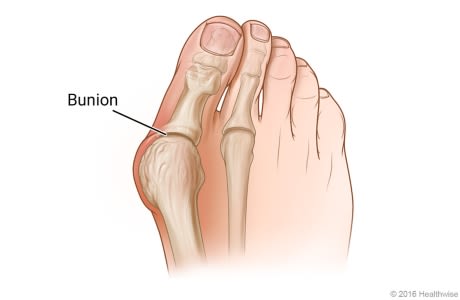Bunion
What is a bunion?
A bunion is an enlargement of bone or tissue around the joint at the base of the big toe. The big toe may turn toward the second toe. The tissues around the joint may be swollen and tender.
A bony bump at the base of the little toe is called a bunionette or tailor's bunion. The little toe also bends inward, and the joint swells or enlarges.
Symptoms
What are the symptoms of a bunion?
Your bunion may not cause any symptoms. Or you may have pain in your big toe, red or irritated skin over the bunion, and swelling at the base of the big toe. The big toe may point toward the other toes and cause problems in other toes.
Bunion: Metatarsophalangeal joint

A bunion (hallux valgus) is an enlargement of bone or tissue around the joint at the base of the big toe (metatarsophalangeal joint). This results in a bump on the outside edge of this toe.
Diagnosis
How is a bunion diagnosed?
Your doctor will ask questions about your past health and carefully examine your toe and joint. Some of the questions might be:
- When did the bunions start?
- What activities or shoes make your bunions worse?
- Do any other joints hurt?
The doctor will examine your toe and joint and check their range of motion. This is done while you are sitting and while you are standing so that the doctor can see the toe and joint at rest and while bearing weight. To rule out other problems, your doctor may also check your reflexes, your pulse, and your feeling in the foot.
Tests that may be done
X-rays are often used to find out the degree of bone deformity or to rule out other causes of pain and swelling. If surgery is being considered, X-rays can help your doctor decide what type of surgery will be most helpful in treating the symptoms. X-rays usually are done while you are standing so that the foot is bearing weight. In some cases, an MRI, a CT scan, or a bone scan is also used.
More tests, such as blood tests or arthrocentesis (removal of fluid from a joint for analysis), are sometimes done if other conditions that can cause joint pain and swelling are suspected. These other conditions include gout, rheumatoid arthritis, and joint infection.
Treatment
How is a bunion treated?
Bunions are treated to ease pain and help with walking and other daily activities. If you have a bunion but don't have pain or discomfort, treatment may not be needed. Another goal of treatment is to prevent the bunion from getting worse.
Most bunions can be treated at home. Surgery is an option only if other treatments don't help.
Nonsurgical treatment
Nonsurgical treatment usually is used to decrease pressure on the big toe and relieve pain. Treatment includes:
- Wearing roomy shoes that have wide and deep toe boxes (the area that surrounds the toes). The shoes should have low or flat heels and good arch supports. Avoid tight, narrow, or high-heeled shoes that put pressure on the big toe joint.
- Using bunion pads, arch supports, or custom-made supports (orthotics). They can help redistribute your weight while you are walking and take pressure off your big toe. Ask your doctor to help you choose the right kind of pads.
- Taking nonprescription medicine to relieve pain and reduce swelling. Examples include acetaminophen (such as Tylenol) and nonsteroidal anti-inflammatory drugs (NSAIDs), such as ibuprofen or aspirin. Talk to your doctor about which pain reliever is best for you.
- Using ice to relieve pain and reduce swelling. Apply ice to the joint for 10 to 20 minutes at a time. Put a thin cloth between the ice and your skin. Prop up your foot so that your toe is higher than your heart.
Surgical treatment
If nonsurgical treatment hasn't relieved toe pain and you aren't able to do normal daily activities, or if you have a severe bunion, you may want to think about surgery. Bunion surgery is done to help restore normal alignment to the toe joint and relieve pain.
There are different types of bunion surgery. The best type of surgery for you depends on how severe your bunion is and how experienced your surgeon is. Look for a surgeon who does many different types of bunion surgery on a regular basis. Each bunion is different, and surgery needs to be tailored to each case.
Relieving pain from a bunion
Home treatment can help relieve toe pain and may prevent a bunion from getting worse. Try the following ways to relieve toe pain.
- Use nonprescription pain relief medicine.
Examples include acetaminophen (such as Tylenol) and nonsteroidal anti-inflammatory drugs (NSAIDs) (such as ibuprofen or aspirin). Talk to your doctor about which pain reliever is best for you.
- Try ice and elevation.
Apply ice to the joint for 10 to 20 minutes at a time. Put a thin cloth between the ice and your skin. Elevate your foot so that your toe is higher than your heart.
- Try bunion pads, arch supports, or custom-made supports (orthotics).
Place these just behind the big toe joint on the bottom of your foot. This redistributes your weight while you are walking and takes pressure off your big toe. Ask your doctor to help you choose the right kind of pads.
- Put moleskin or felt patches over or around pressure areas.
These help protect the bunion from being rubbed by your shoes.
- Stretch the parts of your shoes that rub on painful areas.
Look for a shoe repair shop or cobbler that stretches shoes, or ask your doctor to recommend one.
- Buy special or custom shoes for people with foot problems.
You may need to search for a shoe manufacturer who makes these shoes.
Copyrighted material adapted with permission from Healthwise, Incorporated. This information does not replace the advice of a doctor.
